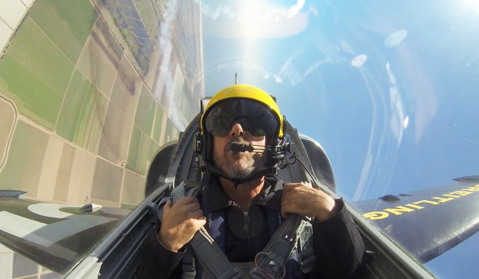
What stands out most during your first flight with the Breitling Jet Team is not the climbs, descents, loops, and barrel rolls but rather how it’s all done with six other aircraft 10 feet away.
I was moderately restless the night before, with wide-eyed visions of my face rippling from the g-forces, wondering if this would be the assignment where I’d lose my lunch, and worrying if a thick marine layer would ground the media flight altogether.
Arriving a half-hour early at Naval Air Station Point Mugu on a sunny Friday morning, I made my way past throngs of people enjoying a pre-air-show performance of helicopters, biplanes, and jets, which were practicing in advance of the weekend event. Upon meeting up with the Breitling Jet Team — a civilian squad of aerobatic flyers sponsored by the Swiss watchmaker — we headed to a long hanger to be fitted with official flight suits and helmets as well as have a safety meeting, where we learned the importance of not touching the plane’s flight stick, foot pedals, emergency hatch, and, of course, the vital albeit hair-raising ejection seat.
Team leader Jacques Bothelin graciously pointed out that Friday’s flight would not be too aggressive, stating that we would experience only 4.5 g-forces, which causes the blood in your head to head south but can be countered somewhat by tightening your stomach muscles. As I attempted to discreetly practice this technique in my seat, clipboards with liability waivers were handed out, which I chose to sign but not read too carefully. Then it was time to meet our pilots.
Georges-éric Castaing, who flies Jet #5, shook my hand with a calm politeness, good eye contact, and quick smile, as if he was used to putting passengers at ease. He offered to Americanize his name and said I could call him George, though I stuck with his stated nickname, “Georgio.” His relaxed demeanor comes no doubt from serving almost 24 years in the French Air Force. He joined at 19 and amassed 5,000 flying hours in Fougas, Tucanos, Alpha Jets, and the Mirage F1 and Mirage 2000. Perhaps to put me further at ease, Castaing casually offered that the Aero L-39 Albatros, the trainer jet that the Breitling team chose for their fleet, is “not that fast,” only traveling in the 500 mph range.
Castaing took up a “new life” with Breitling about two years after leaving the military. He said he’s happy to be a part of the team and feels lucky to be able to tour the U.S. and Canada this year. He cited the perks of traveling, like performing for and meeting with people from all over the world. “I really love to see the Earth from my aircraft with all the different sceneries,” he said. Travel was mentioned as a downside, as it keeps him away from his wife and three children, but the team does get breaks in the tour when he can go home to France for a visit.
After we finished with our paperwork and safety briefing, seven pilots and seven passengers made their way out of the hanger in flight suits and carrying helmets — the experience evoked a reenactment of Reservoir Dogs crossed with The Right Stuff.
The L-39s seat two, each with his own controls. We were helped into the rear cockpit by crewmembers and reminded again not to touch anything before the GoPro camera was turned on and the hatch secured. The engines fired up, and we taxied one-by-one to the runway. The fumes of jet fuel and exhaust were strong in the cockpit as we sat with the sun beaming down on our black flight suits. I was struck by how similar it felt to waiting for a regular flight on the tarmac when Georgio’s voice, seemingly anxious to be in the air, came through the headset: “This is the worst part of the flight.”
In no time at all, we were at one end of the runway and taking off before quickly assembling over the Pacific Ocean in a tight formation of seven. The view was oddly similar to many other flights I’ve taken, but with one major difference — at every turn, roll, and dive, there was at least one other aircraft about 10 feet away while the squadron flew as one. It was a beautiful and awe-inspiring sight, to say the least.
Jet #5’s position was in the back-right part of the formation, and immediately visible was the constant movement and flap adjustment each plane made to maintain its position. The engine’s response time can be slow, so pilots tend to stay on the throttle while feathering the air brakes. When watching from the ground, the jets appear to fly in perfect lockstep, but in reality, with wind, thermals, and other factors, there is a constant series of small adjustments that need to be made. “Nothing is automatic, everything is manual,” Castaing later told me. “It is a real pleasure to fly this bird because a pilot wants to fly and handle his aircraft.”
Our first big move was a loop over the ocean. I was giddy as a kid. We then went into a series of banks-rolls and turns using the airspace above Pt. Mugu and the surrounding agricultural fields as our personal playground. We spent 25 minutes on an invisible roller coaster occasionally leaving smoke trails as artful proof of our feats. The aerobatics performed were a combination of thrilling and relaxing, and before long, each jet split off one-by-one with a barrel-roll back to the runway.
Castaing climbed out of his cockpit and opened my hatch, secured the safety pins that disable the ejection seat, and unlocked my harness. “How was it?” he asked. Amazing. I went up one person and came down another.




